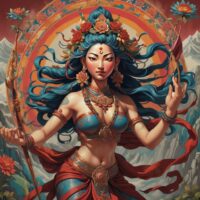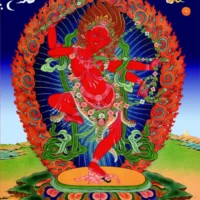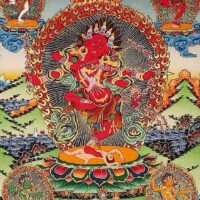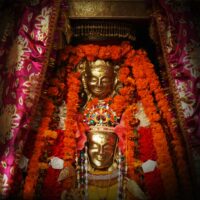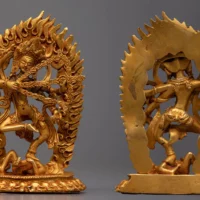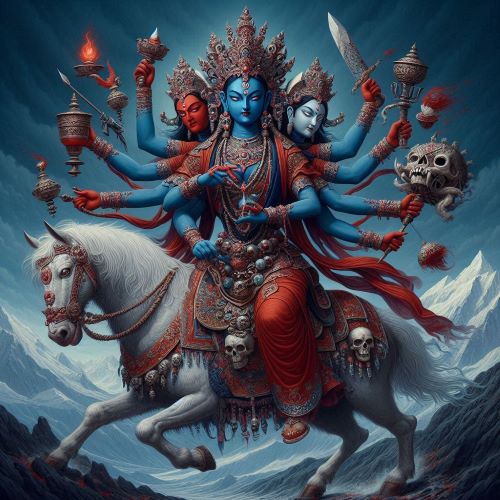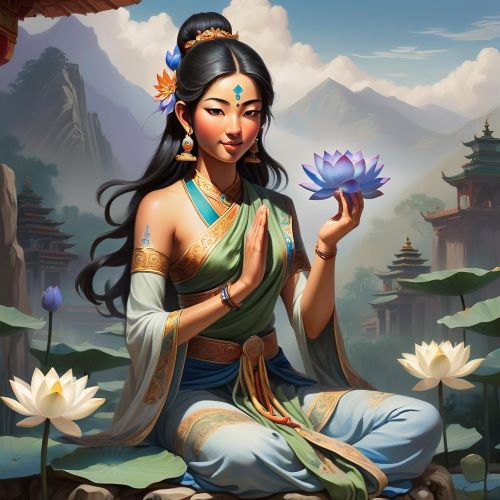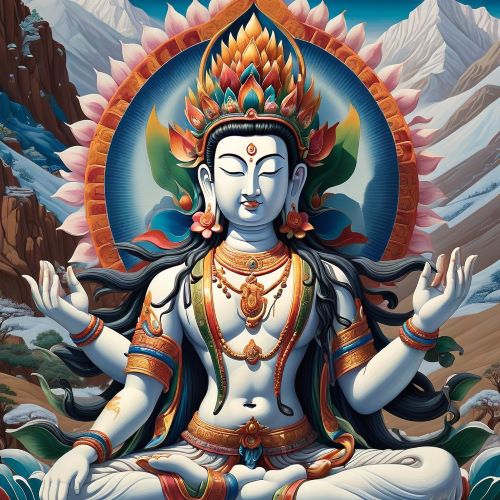Kurukulla : Goddess of Love
Listen
At a glance
| Description | |
|---|---|
| Origin | Tibetan Mythology |
| Classification | Gods |
| Family Members | N/A |
| Region | Tibet |
| Associated With | Love, Enchantment |
Kurukulla
Introduction
Kurukulla holds a significant place in Tibetan Buddhism as a goddess associated with love, enchantment, and attraction. Devotees call upon her during rituals designed to draw in positive energies, create harmonious relationships, and clear obstacles from their paths. Her importance within Tibetan mythology embodies the spiritual and cultural values of the Tibetan people, underscoring themes of compassion, wisdom, and the interconnectedness of all life.
As a female deity revered mainly in the Vajrayana tradition, Kurukulla can manifest in various forms, each embodying different aspects of Buddhist cosmology. She is particularly noted for her ability to tame desires and illusions, serving as a reminder of the distractions that can impede spiritual growth. Her role in magical practices and rituals underscores her status as a transformative force, guiding practitioners from the allure of worldly attachments toward a deeper understanding of spiritual enlightenment. Often called upon for success and fortune, Kurukulla inspires not only reverence but also introspection on the nature of desire and attachment.
Physical Traits
Kurukulla is often depicted as a vibrant and alluring figure, balancing the qualities of beauty and fierceness. Her striking red complexion symbolizes power, passion, and vitality, highlighting her role as a goddess who influences emotions and desires. In her iconography, red is a dominant color, representing both her energetic nature and her fierce aspect. She is adorned with various ornaments that signify wealth and success, reinforcing her identity as a goddess of abundance. Frequently portrayed in a dancing posture, Kurukulla embodies the dynamic movement of spiritual awakening, inviting devotees to embrace transformation.
Her physical attributes include four arms, each holding symbolic objects such as a bow and arrow made of flowers, a hook, and a noose. These elements signify her ability to attract and bind, showcasing her power to subdue negative forces while emphasizing the dual nature of desire. Kurukulla’s captivating eyes reflect compassion, reinforcing her role as a loving deity. Overall, her representations serve as a reminder of the transformative potential of desire, inviting practitioners to harness it as a force for enlightenment rather than a source of distraction.
Family
Kurukulla is woven into a rich tapestry of Buddhist deities, sharing familial ties with prominent figures in Tibetan mythology. Some texts identify her as a manifestation of Tara, a highly revered goddess known for her compassion and protective qualities. This connection underscores her role in offering guidance and support to devotees, reinforcing the idea that female deities in Tibetan Buddhism often work together to foster spiritual growth.
In different narratives, Kurukulla is linked to Padmasambhava, a pivotal figure in establishing Buddhism in Tibet, as well as various bodhisattvas. Her associations with male deities, including a consort, further emphasize the harmony between masculine and feminine energies in Tibetan spiritual practice. This familial context illustrates the collaborative nature of the divine within Tibetan Buddhism, where the interplay of different deities enriches practitioners’ understanding of the universe’s spiritual dynamics and their own journeys.
Other names
Kurukulla is recognized by a variety of names, each highlighting a different facet of her multifaceted nature. The primary name, Kurukulla, is commonly used in Tibetan texts and signifies her core identity. Adding “Shri” to her name creates Shri Kurukulle, which means auspicious or revered, emphasizing her esteemed status in Buddhist practices. Another significant title, Red Tara, underscores her connection to the goddess Tara and highlights her fiery aspect as a compassionate guide for practitioners on their spiritual paths.
In addition to these titles, Kurukulla is sometimes referred to as Uddiyana Kurukulla, linking her to the mystical land of Uddiyana, known as a source of tantric teachings. These various names not only reflect the diverse ways Kurukulla is revered across different sects and regions but also reveal the rich symbolism and cultural nuances embedded in Tibetan Buddhism. Each name offers insight into her character and the spiritual dynamics she embodies, enhancing practitioners’ understanding of her role in their journeys.
Powers and Abilities
Kurukulla is celebrated for her extraordinary powers, primarily linked to love, desire, and mental transformation. One of her key abilities is Desire Control, where she helps practitioners navigate their attachments, encouraging them to see desire as an essential aspect of their spiritual journey rather than something to be shunned. This unique perspective allows individuals to embrace their desires and learn from them.
Another remarkable aspect of Kurukulla’s powers is her Spellbinding Charm, which captivates hearts and minds during rituals designed to attract success or love. While this enchanting ability is powerful, it comes with a cautionary note to ensure that desires align with spiritual objectives. Additionally, she is associated with Healing, often called upon for emotional and psychological support, aiding in the alleviation of distress caused by strong attachments. As a protector, Kurukulla offers both physical safety and spiritual guidance in times of need. Her powers embody a blend of compassion and strength, facilitating profound transformations while emphasizing the intricate relationship between desire, attachment, and spiritual growth.
Further enhancing her formidable presence, Kurukulla possesses the ability to attract positive energies, people, and circumstances. This aspect is frequently invoked in rituals aimed at fostering love and success. Her iconic bow and arrows made of flowers symbolize her capacity to pierce through negativity with love and compassion, turning adverse feelings into positive experiences. Moreover, she wields tools like the hook and noose, representing her power to subdue and bind negative forces, effectively shielding her devotees from various obstacles. Through her enchanting influence, Kurukulla fosters understanding and cooperation, encouraging harmony among all beings.
Modern Day Influence
In today’s world, Kurukulla’s impact is becoming increasingly apparent as both practitioners and scholars delve into the significance of her teachings for personal and communal spiritual growth. Her mythology offers profound insights into the nature of desire and attachment, inspiring those seeking empowerment and guidance. Many Tibetan Buddhists actively incorporate Kurukulla into their rituals, focusing on themes of prosperity, love, and success. These practices emphasize the importance of intention behind one’s desires, making her teachings particularly relevant for modern spiritual seekers.
Kurukulla’s influence extends into contemporary art and culture, where she is celebrated through various mediums, including paintings, sculptures, and dance. This artistic representation plays a crucial role in reviving traditional Tibetan practices among younger generations. As discussions around gender and spirituality evolve, Kurukulla has emerged as a symbol of feminine power, showcasing the vital role of women in religious contexts and challenging patriarchal norms found in many traditions. Furthermore, academic studies explore her contributions to understanding psychological concepts related to desire and transformation, effectively linking ancient narratives with modern psychological theories.
Ultimately, Kurukulla stands out as a dynamic figure in Tibetan mythology, embodying the complexities of desire and transformation. Her physical attributes, familial connections, and contemporary influences highlight the richness of her character and teachings. As spiritual seekers continue to explore her legacy, Kurukulla remains a beacon of love, compassion, and interconnectedness, demonstrating the timeless relevance of Tibetan mythology in addressing the spiritual needs of today’s world.
Related Images
Frequently Asked Questions
What is lorem Ipsum?
I am text block. Click edit button to change this text. Lorem ipsum dolor sit amet, consectetur adipiscing elit. Ut elit tellus, luctus nec ullamcorper mattis, pulvinar dapibus leo.
What is lorem Ipsum?
I am text block. Click edit button to change this text. Lorem ipsum dolor sit amet, consectetur adipiscing elit. Ut elit tellus, luctus nec ullamcorper mattis, pulvinar dapibus leo.
What is lorem Ipsum?
I am text block. Click edit button to change this text. Lorem ipsum dolor sit amet, consectetur adipiscing elit. Ut elit tellus, luctus nec ullamcorper mattis, pulvinar dapibus leo.
What is lorem Ipsum?
I am text block. Click edit button to change this text. Lorem ipsum dolor sit amet, consectetur adipiscing elit. Ut elit tellus, luctus nec ullamcorper mattis, pulvinar dapibus leo.
What is lorem Ipsum?
I am text block. Click edit button to change this text. Lorem ipsum dolor sit amet, consectetur adipiscing elit. Ut elit tellus, luctus nec ullamcorper mattis, pulvinar dapibus leo.


